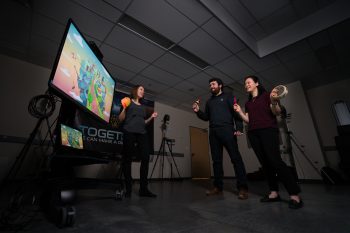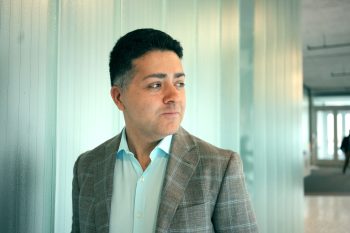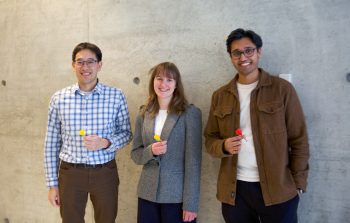As the global response to COVID-19 unfolds in real time, public health officials are urging unprecedented measures in order to “flatten the curve.” But how do we know which actions are likely to slow the spread, and by how much?
The answer is pandemic models, and U of T Engineering professor Dionne Aleman (MIE) has first-hand experience in building these.
Aleman is an expert in the field of operations research, focusing primarily on applications in human health. Ten years ago, she created a model of a hypothetical pandemic and used it to explore how factors such as demographic variations in transmission rates or mitigation strategies affected the demand on health care services.
“These models can be used as ‘what if machines’ to help public health officials answer questions like ‘Is strategy A more effective than strategy B?’ or ‘Will this strategy have unexpected consequences on health-care providers?’” explains Aleman.
Writer Liz Do spoke to Aleman to learn more about her research, and how simulations and modelling play a vital role in pandemic preparedness.
Explain your research in the area of pandemic planning. What do your models actually model?
My research focuses on creating the ability to model heterogeneous people. This takes into account unique transmission and susceptibility rates — based on age and health status — as well as unique behaviours. These behaviours include, for example, choosing to take public transit, or choosing to stay home when sick. We account for how contagious diseases spread based on these highly specific person-to-person scenarios.
We can, and do, model anything for which there is data, including infections by demographic, deaths by demographic, Intensive Care Unit (ICU) bed usage by hospital, health-care worker infections or absenteeism by hospital, and so on. We also incorporate mitigation strategies, such as social distancing and vaccine centres, as well as closures of schools, transit, and high-volume businesses, like restaurants.
We start with a large simulation model and distill that model into a large network where people are represented as nodes and contact between two people is an arc between those nodes. From this network, we can use optimization methods to identify the most critical people in the population: these are the ones to prioritize for vaccinations, or to quarantine to minimize disease spread. The most critical people can often be identified by their occupation, neighbourhood, age, and use of certain transit routes.
How do your models differ from traditional predictive models?
Most pandemic models are based on a concept called the reproduction number, or R0. This number is the average number of infections that one infected person will cause. COVID-19, for example, has R0 around 2.3, according to the most recent estimate I’ve seen, though this number is still evolving as more data becomes available.
This number is good for quickly predicting overall levels of infections over time and the impact of reducing R0 through, say, social distancing. R0 can be different in urban versus rural environments and can even vary in different parts of large cities.
It also cannot reliably capture targeted mitigation strategies like school closures or vaccines and quarantines for high-risk individuals. Our models build unique individuals for everyone in the city based on known demographics, ages, school usage, workplaces, transit use, etc. This means they can capture data on individual health changes and more accurately model the effectiveness of targeted mitigation strategies.
A drawback of this approach is that much more data is required. An important caveat is that all pandemic models are heavily based on estimates and assumptions, and while the general trends and impacts of disease spread can be faithfully predicted, the exact numbers of what happens, and when, should be taken with a grain of salt.
Where have your models been implemented?
My models were developed in consultation with researchers at the Ontario Agency for Health Protection and Promotion (OAHPP), now called Public Health Ontario (PHO), several years ago. We have since greatly expanded the granularity of the models and our optimization techniques.
Can your models predict outcomes such as how many cases will be in in East York versus North York, or which hospitals will get overwhelmed first?
Yes and no. A simulation of a pandemic will indicate pandemic demands at each hospital and which hospitals are hardest hit, but each simulation is just one flip of the coin, just one possibility.
There are lots of random events involved, so the same scenario in another simulation might indicate very different results.
As an example, consider the current COVID-19 outbreak as one scenario, and consider another scenario where patient zero in Wuhan conveniently self-isolated for two weeks and infected no one else. Obviously, these two scenarios have drastically different world impacts even though they start with the same disease and the same first patient.
So, we have to run hundreds of simulations to understand what is happening on average, or in, say, 90 per cent of scenarios. If the same hospitals show up regularly as among the hardest hit, then we can feel confident saying those hospitals will be hardest hit in the event of a real pandemic.
How does your model incorporate the effects of social distancing?
We can define both social distancing and compliance probabilities, meaning how likely a person is to socially distance themselves from others, and how likely a person is to follow public health guidelines or mandatory quarantines. These probabilities can be adjusted depending on how effective we think the messaging from the government and the media is, or perhaps more relevant today, how susceptible people are to misinformation campaigns, like claims that COVID-19 “is just like the flu” or that you can substitute soap and hand sanitizer with essential oils.
A concept that has gotten widespread attention these past few weeks is “flattening the curve.” How important is this strategy in mitigating a spread, especially in an urban setting like Toronto?
Flattening the curve is extremely important everywhere in Canada and most of the world, urban or not.
It’s all about slowing the spread of the disease, even if the total number of infections remains the same, so the peak number of infections — the maximum number of pandemic patients the hospitals would have to handle at once — is dramatically reduced.
A hospital may be able to absorb an extra 100 COVID-19 patients at any one time, but not an extra 1,000. Given the high probability of infected patients requiring ventilators, the availability of ventilators also becomes problematic if the curve is not flattened.
There are about 15 ventilators per 100,000 people in Canada, with 90 per cent of those ventilators already in use, leaving about 1.5 ventilators available per 100,000 people, so if even an additional few thousand patients nationwide need ventilators, this may mean that some patients don’t get them, whether those patients are COVID-19 cases or other ones. Provinces and territories with lower ventilator availability are particularly at risk.
In 2011, you developed a simulation model that tested a pandemic influenza outbreak in the GTA. Can you take us through those learnings and outcomes, and how this might be applied to the current COVID-19 outbreak?
Early and bold interventions are best to stem pandemic disease spread. We consistently found that closing schools, closing some high-volume transit routes, and vaccinating targeted populations, such as people within certain age groups or workers with high-volume public contact, were most effective.
Until recently, I would never have thought that actions as drastic as school closures would be considered, due to the political ramifications. I am very impressed to see school and university closures happening nationwide before the country is overwhelmed by COVID-19.
Science is clearly leading the way in the government’s decision-making process, and that is how it should be. We are at a crossroads right now — we can ask people to be careful but proceed with their usual life, or we can take bold, but temporary, action and prevent us from suffering tens of thousands of infections and deaths.



